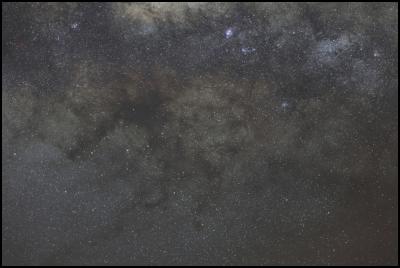Kiwi discovered in outer space
Media release from Mt John Observatory, Lake Tekapo
28
September 2009
Kiwi discovered in outer space

Click for big version
Spot the Kiwi
An astrophotographer has discovered a kiwi in outer space from New Zealand’s internationally renowned Mt John Observatory.
It may be 26,000 light years away but a high powered astro-photograph has picked up the distinct image of New Zealand’s national icon in the centre of the Milky Way Galaxy.
The incredible image of the flightless bird was captured by experienced photographer Fraser Gunn. Mr Gunn, who has recently begun astrophotography with Earth and Sky Stargazing Tours at Lake Tekapo’s Mt John Observatory, is delighted with the discovery.
“When looking at the area with the naked eye it’s difficult to locate the kiwi but my camera allows greater light and colour into the image giving it more definition.
“We only started the astrophotography tour six weeks ago to complement our stargazing tours and the response so far has been outstanding. Basically, I provide instruction to anyone with a SLR-type camera so they obtain their own starlight pictures,” he says.
Graeme Murray, director of Earth and Sky Tours, says Fraser has become a leader in New Zealand astrophotography and is fast gaining international acclaim.
“His animation scenes of the night sky are quite remarkable. On a series of clear nights Fraser has taken a sequence of more than 1,000 photos between sunset and sunrise and then condenses the shots into about two minutes. It captures the full picture of what’s happening in space, complete with shooting stars and passing satellites, and is absolutely fascinating.”
Run by the University of Canterbury, Mt John Observatory is the centre of New Zealand's space research programme and is regarded by astronomers as possibly the best site in the world to view the Milky Way and the centre of our universe. Its uniquely dark skies, devoid of city light pollution, and high number of clear nights and atmospheric stability and transparency make it perfect for stargazing.
The Mackenzie region, where Mt John Observatory is based, is considered New Zealand’s best stargazing spot and has been named the fourth best place in the world to go stargazing by United States travel website VirtualTourist.com.
In fact, the quality of stargazing is so good that the Mackenzie region has a bid underway to establish its night skies as a UNESCO World Heritage Starlight Reserve.
Earth and Sky Tours has been operating astro-tourism tours at Mt John Observatory for the past five years and Mr Murray says he’s noticed a considerable national and international increase in public awareness about the night sky during that time.
“More than 50,000 people have been on our day, night and ‘behind the scenes’ tours in the past year alone,”he says.
“The kiwi is a great discovery for the Earth and Sky team on Mt John and how appropriate it is that a kiwi stands amongst the stars we are striving to protect.”
More about Earth and Sky
Tours
On clear nights, Earth and Sky Tours run stargazing tours from sunset onwards. Astronomy guides help visitors navigate the southern night sky using powerful laser pointers, telescopes and binoculars to explore the universe and view distant planets, stars and solar systems.
In the daytime, visitors can take a 40-minute observatory tour to see where astronomers work at night and learn more about deep space research, the exciting new MOA (Microlensing Observations in Astrophysics) project, geographical features of the Mackenzie Basin, and local lore. The tour is topped off with a visit to the MOA telescope and, on a clear day, the chance to view a planet or distant star.
Afterwards they can enjoy great coffee, food and breathtaking 360 degree alpine views at the all-glass mountain top AstroCafe, described by Lonely Planet as "possibly the best place on this globe for a cup of coffee".
ENDS


 John Mazenier: Gaffer Tape And Glue Delivering New Zealand’s Mission Critical Services
John Mazenier: Gaffer Tape And Glue Delivering New Zealand’s Mission Critical Services Earthquake Commission: Ivan Skinner Award Winner Inspired By Real-life Earthquake Experience
Earthquake Commission: Ivan Skinner Award Winner Inspired By Real-life Earthquake Experience Reserve Bank: Consultation Opens On A Digital Currency For New Zealand
Reserve Bank: Consultation Opens On A Digital Currency For New Zealand NIWA: Ship Anchors May Cause Extensive And Long-lasting Damage To The Seafloor, According To New Research
NIWA: Ship Anchors May Cause Extensive And Long-lasting Damage To The Seafloor, According To New Research New Zealand Customs Service: A Step Forward For Simpler Trade Between New Zealand And Singapore
New Zealand Customs Service: A Step Forward For Simpler Trade Between New Zealand And Singapore Horizon Research: 68% Say Make Banks Offer Fraud Protection
Horizon Research: 68% Say Make Banks Offer Fraud Protection



